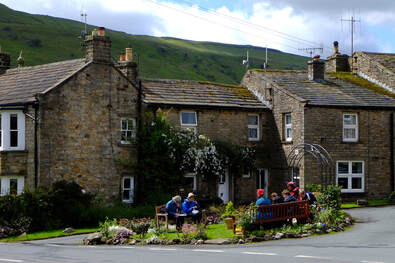 Image by Paula Beaumont PaulaBeaumontAdventures.co.uk
Image by Paula Beaumont PaulaBeaumontAdventures.co.uk It may appear like a forgotten little settlement now but Gunnerside was once of much greater size and significance.
The village's origins go back to the 10th century when Gunnar had his summer pasture there.
For centuries it was a centre for dairy farming. Gunnerside butter, perhaps all the richer thanks to those ultra verdant and rich meadows, is said to have been sent as far away as London.

This was when many cottages were built to accommodate some of the miners who moved into the area. Some were built on to existing dwellings and farms and the thatched (often made from heather) roof was removed from some single story buildings to add another level. Gunnerside would have felt like quite a bustling place, with much traffic coming into and out of the dale. New Bridge was built in the 1830s, when the dale was much busier.

Above Gunnerside the landscape resembles a moonscape (or at least that's how I imagine the moon surface!), contrasting with the greener pastures and wooded areas below. It's not difficult to find remains of lead mines and when you wander among the old lead mine workings in the more isolated parts of the dale, the harshness of the life of a miner becomes apparent, particularly on a cold, windy day.
Unlike some settlements that were once part of large country estates, Gunnerside has many individual smallholdings, partly thanks to the dale's tradition of dividing land between children instead of the eldest son automatically inheriting. Farm incomes were often supplemented by spinning or weaving wool and hand knitting wool clothing, which was then taken to market in Richmond.

The old Smithy dates back to around 1795 and is now owned by the sixth generation of the Calvert family to work the forge. The small building contains some historic items from the times when lead mining was an important source of income in the dale.
The meadows around Gunnerside are rich in wild flowers in Spring and early Summer and the ancient woodlands are carefully managed to maintain their character and biodiversity.

 RSS Feed
RSS Feed
